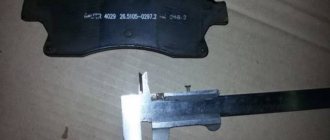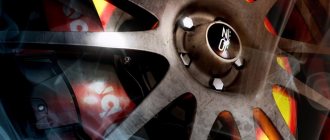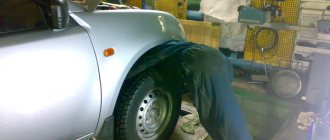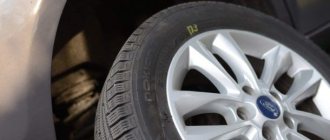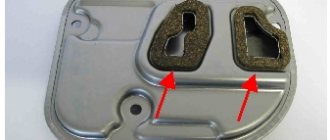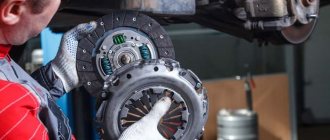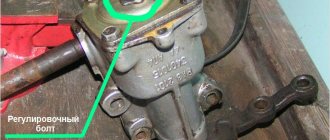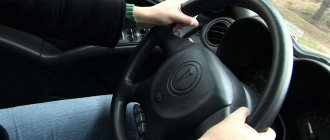Hi all! It is unlikely that anyone will argue with the fact that proper operation of the braking system is the key to the safety of every driver. Therefore, today we will continue this topic by talking about why the caliper is knocking, what to do in this situation and who is causing the noise.
Surely everyone knows that you should always monitor the degree of wear of the brake discs. We also talked to you about grooving brake drums, and also studied the nuances of grooving brake discs yourself. I don’t encourage you to do this yourself, but you must know the features and tasks of such procedures.
The caliper refers to the braking system of a vehicle. It comes in both front and rear. But in both cases, his treatment is carried out approximately according to the same scheme. And the reasons for the knocking are identical.
Possible reasons
To repair a fault, it must be found. Therefore, first we will look at the main causes of caliper knocking:
- Worn pads. Actually, it is not the caliper that is knocking, but the pads;
- The guides were taken out, as a result the caliper moves along them, while it knocks;
- The bolts holding the caliper have come loose.
Each of these problems has its own methods and repair methods. Let's look at them in more detail.
This is interesting: Lada Vesta fuses: where they are, replacement
The mount has come loose
This happens, but quite rarely. A common reason is traveling on poor quality roads. Vibration can cause bolts to become loose and unscrewed. Usually, this happens soon after a repair affecting the caliper. In this case, you or the master simply did not tighten the bolts. For prevention, always pull fasteners with a certain torque when assembling.
This will save you from problems. To eliminate this knocking noise, simply tighten the bolts. If one of them is lost, make sure it is not broken off and screw on a new one. The broken bolt will have to be drilled out.
Conclusion
. There are quite a large number of different mechanisms near the wheels. They periodically fail. Therefore, the question of what to do if the calipers are knocking is not uncommon. In many cases, this is a design feature that will be quite problematic to eliminate. But it is still quite possible.
Looking for the root of the problem
So, what causes such a characteristic ringing? The reason lies in insufficient pressure of the pads to the discs. As a result, a gap appears between them. On bumps, the pads vibrate and involuntarily come into contact with the surface of the disc.
This is what causes the haunting sound. What is noteworthy is that from the street it looks more like a ringing sound. And dull blows are felt inside. Sometimes this indicates a problem with the shock absorbers or ball joint. But don’t rush things and sort out the suspension. Perhaps your brake calipers are just rattling.
Build error
If the pads begin to rattle after overhauling the brake system or replacing them, this may indicate an error occurred during installation work. At the same time, one should not exclude the risk of installing low-quality consumables, which cause extraneous sounds.
The most common error during assembly is poor fixation of the inner pad by the petals in the piston. In this case, you need to get it out by disassembling the caliper. Next, you should bend the petals further and mount everything in place.
Pads
Often, a metallic grinding sound is added to the knocking. This happens when the lining on the block has been removed completely. The knocking does not come from the caliper itself, but from the pads. The repair consists of replacing the pads. If you ignore the problem, your braking performance will be significantly reduced. But that's not all.
Having worn down to iron, the pads actively wear down the brake disc. A hundred kilometers in this mode and it will simply “cut off”. And you will have to buy a new disk at the store. It can also easily push out the working cylinders. This is fraught with jamming. The most common problem in this case is brake fluid leakage.
What to do if the pads rattle in the caliper immediately after replacement?
In this case, the culprit of the problem is a disk that is too thin. Typically its service life ranges from 120 to 200 thousand kilometers. With significant wear, neither lubricant nor additional plates will help restore the previous gap. There is only one way out of the situation - replacing the brake disc with a new one.
Some produce grooving of this element. But it is worth remembering that such an operation is performed only if the part is sufficiently thick. In our case, this operation can also cause harm.
If the calipers rattle, what should I do? If you install a new disc and pads, the problem should be solved. But if it remains, you can try replacing the clamping bracket.
Plate
Many manufacturers install special anti-squeak plates from the factory. They follow the contours of the block and are up to one millimeter thick. Many people do not see the point in installing these elements. But they have an effect. If the spring is not able to properly press the pads, this pad partially compensates for this gap. If the calipers rattle, what should I do? It is necessary to inspect the brake mechanism and check for the presence of an anti-squeak plate.
Note! Even on a fully functional car, there should be a small gap between the working surface of the disc and the friction material of the pad. But it is so insignificant that the sound from the contact of parts is not reproduced. If the brake elements are fairly worn out, you should not add several plates at a time. This may interfere with the braking system, and the effect will be disappointing.
Guides
The caliper is constantly subject to quite heavy loads. Therefore, problems with them are not uncommon. And on some Chevrolet models, this is a generic disease that appears after 20,000-30,000 kilometers. There are several ways to fix this problem:
- Replacing guides. This method does not always help. We buy a set of new guides and install it. If everything is in order, then the problem will disappear. But, she will return after some mileage. When the knocking occurs again depends on the characteristics of your vehicle. In some cases, the knocking noise is caused by wear on the guide seats. Dealing with such a malfunction is much more difficult. In this case, special rubber bands are installed on the pins. To do this, you will have to purchase special reinforced guides. But this pleasure is not cheap. Each set contains only 1 elastic band. Accordingly, one wheel will require from 2 to 4 sets. But, you will forget about the knock for quite a long time;
- There is a special lubricant for calipers. In general, this is a preventive measure. But, in some cases it helps to get rid of knocking. To use, pull the guide out of its seat and lubricate it thickly with lubricant. After that, we place part of the lubricant in the socket. We insert the pin into place and secure it. Depending on the degree of wear and the quality of the lubricant itself, one treatment should be enough for 500-10,000 kilometers. This lubricant is usually sold in small bags per guide;
- There is also a rather radical way to solve the problem. This is the addition of a spacer spring. To do this, you will have to drill holes in the caliper and brake cylinder block. After which, the parts are tightened using a spring. Suitable from VAZ drum brake repair kit.
This is interesting: How to add distilled water to a battery: how much liquid should be
The solution couldn't have been simpler
I spent several hours on auto forums, where many advised replacing the caliper guide with rubber and making a bracket with a spring on them. In general, I began to think that there was no simple solution. However, I read somewhere that there is a miraculous American high-temperature lubricant for calipers and supposedly, not only does it not wear out for a very long time, but it also completely eliminates the nasty sound. It's called Permatex Ultra Disk Brake Caliper Lube.
Well, it is said, so it is said. I called all the auto stores and found it. It turned out that the bag costs 50 rubles. It contains four grams, enough for exactly one caliper.
I went and picked it up, jacked up the car right at the entrance, took off the wheel, took a rag, and wrapped it around a sushi stick. Using the resulting tool, I first cleaned all the protective rubber bands from the inside, then the guide wells themselves. After which I put rubber bands on the guides, filled them with grease, lubricated them themselves (important) and sent them into the wells.
After I assembled it, I basically forgot about the sounds from the brake mechanisms; this year I checked it while climbing. The grease looks the same as when I put it in.
In general, I recommend that you get rid of knocking in the calipers using the method described above.
Inspection of calipers
In 40 percent of cases, the front caliper rattles due to dry lubricant. Many car owners do not know that this part requires periodic maintenance. How often should you do it? Experts give the answer - lubrication is carried out every time the pads are replaced. The service life of the latter can range from 20 to 60 thousand kilometers, depending on the location (front or rear), as well as the driver’s driving style.
How to perform an audit? First you need to find a quality lubricant. It must be specialized - specifically for guides. Reviews do not recommend using grease for hubs, as well as copper and ceramic analogues. They dry out quickly and are not suitable for use in this location. A popular manufacturer of specialized lubricants for calipers is Liquid Moly. Typically this product is sold in vacuum bags. One is enough for two guides. The lubricant does not lose its properties at temperatures up to 200 degrees Celsius.
Note! If the piston boot is damaged, it must be replaced immediately. Otherwise, the rear and front calipers will rattle constantly.
The same work must be done on the adjacent brake mechanism. In order not to run to the store when you discover a damaged boot, it is recommended to purchase a repair kit in advance (in extreme cases, it will remain “in reserve”).
How to eliminate the reason why the calipers rattle?
If one of the signs of wear on the guides is detected, in order to prevent the caliper from jamming, it is necessary to disassemble the caliper and replace the worn pins and boots, adding the required amount of lubricant. Therefore, it is better to contact a car service center, because... This problem cannot be resolved on site.
For guide pins, a special synthetic high-temperature silicone-based lubricant is required. IMPORTANT! Lithol and copper-graphite lubricants are absolutely not suitable for this, as they corrode the rubber boots and dry out over time, which leads to the caliper jamming.
To less often encounter the consequences of untimely replacement of caliper guide pin boots, replace them with polyurethane ones. CS20 polyurethane boots are resistant to any lubricants, are not afraid of mechanical damage and last much longer than rubber ones. With the help of polyurethane boots, you can extend the life of the caliper, thereby ensuring safe braking and protecting the mechanism from jamming.
Blog - Hello comrade!
Many people are faced with a fairly common problem: caliper rattling. The main symptom is a metallic rattle, which disappears if you lightly press the brake and mainly appears on cobblestones or similar roads and is also clearly audible when you get into holes. The sound itself can be either sonorous or more dull. The main reason is the broken holes for the guides due to untimely maintenance. Although once a year it is necessary to check the presence of grease on the caliper guides, as well as the condition of the rubber boots.
How to eliminate knocking calipers
If the knocking has just appeared recently, an inspection of the calipers may help, that is, lubricating the guides with high-quality lubricant and checking the boots.
It is important to use high-quality lubricant special for guides. It is not recommended to use copper, ceramic or hub grease. These types of lubricants will jam the caliper guides under certain conditions. The optimal lubricant for guides is SLIPKOTE 211 DBC or similar. If the necessary lubricant is not available, as a last resort, use blue lubricant for the hubs, up to 170 degrees; without sudden braking, such lubricant will work normally. In principle, there were no problems with it on the Starex bead; the anthers did not swell.
How to choose guide pin boots for the caliper.
The size of the boot must correspond to the parameters of the guide pin. It is not recommended to purchase boots of a smaller or larger size, since the main purpose of the boot is to protect the moving mechanism and retain a sufficient amount of lubricant. CS20 boots are manufactured to exact factory dimensions and are suitable for domestic cars of the following brands:
• LADA Kalina 1 and 2 / Granta / Priora; • VAZ 2108-099 / 2110-12 / 2113-15; • GAZelle 3302 and Sobol 2217; • Volga 31029 / 3102 / 3110 / 31105.
If the diameter and length of the boot match, then they can be installed on foreign cars.
• 2108-3501019 (for VAZ cars); • 3105-3501216 (for GAZ vehicles).
How to get rid of knocking calipers on front-wheel drive LADAs
Owners of cars of different brands encounter extraneous noise from brake calipers, and LADA is no exception. Most often, drivers of Grant/Kalina, Largus and Vesta encounter this problem. The malfunction is less common on Priora and XRAY. Let's consider what can be done in this case.
To make sure that extraneous noise while driving comes specifically from the brake mechanisms, you need to rock the caliper from side to side (you can do this without removing the wheel):
Front wheel brake diagram:
1 – wheel cylinder; 2 – fitting for bleeding the brake drive; 3 – sealing ring; 4 – piston; 5 – protective cap; 6 – retaining ring; 7 – caliper; 8 – pad guide; 9 – brake pads; 10 – protective cover; 11 – guide pin; 12 – guide pin fastening bolt; 13 – brake hose; 14 – bolt securing the cylinder to the caliper.
The sounds may resemble metallic knocking, rumble, clanging, strumming, etc. The first step is to contact your dealer with the problem. As far as we know, there are no AvtoVAZ regulations in this case. If the official representative refuses, you can try to get rid of the knocking of the calipers yourself using one of the suggested methods:
1. Fill the guide pins with refractory grease (it’s called “Grease for calipers”).
2. Replace the caliper guide pins with new ones.
3. Make a small groove in the guide fingers (using a lathe), onto which we put a ring made of oil-gasoline-resistant and heat-resistant rubber.
4. Make new guides (using a lathe), which will be slightly larger in diameter than the old ones.
5. Replace brake pads. It is better to choose ones that have a special rubberized coating on their outer side (survey for Vesta, Largus, Granta/Kalina/Priora).
6. Tighten the brake pad guide using a plastic clamp or spring (can be done without removing the wheel).
7. Fold the top of the noise reduction plate (number 4) down. This will get rid of the rattling of the calipers on Vesta:
This method is also shown in the video:
Information letter No. 19-18: When contacting owners of Lada Vesta cars, the effect of “noise from the brakes of the front wheels” emitted when driving on roads with broken surfaces is functional and cannot be eliminated under the warranty obligations of AvtoVAZ PJSC.
Have you encountered rattling noise from the calipers on your LADA? Did the official dealer help in this situation or did you have to fix it yourself? Let us remind you that knocking noises in the front part of the car can come from the suspension (for example, on Vesta from the anti-roll bar) or from the engine mount.
Problems with pads
To identify the reason why the brakes rattle, you should check the pads. A visual inspection may reveal that:
- counterfeit products;
- consumables are completely worn out;
- unsuitable pads are installed, for example, from another vehicle.
The most common noise in the caliper is fake. The main causes of knocking are shown in the table below.
Table - Origin of knocking noise from counterfeit pads
| Reason for knocking | Note |
| Delamination of friction material and support lining | Occurs when the manufacturer uses an adhesive mixture with poor adhesion. |
| Friction lining melting | Friction material particles stick to the disc, causing vibration and knocking as it rotates. |
| Baseplate geometry mismatch | There is a loose fit and uneven distribution of braking forces |
| Incorrect pad dimensions | There is a possibility of play in the seat |
Fake pads after 2500 km
If problems arise with the pads, they need to be replaced. In some cases, it is possible to modify the consumable, for example, if the geometry or dimensions differ from the required ones.
In this case, car owners are advised to remove excess parts of the friction material using a file. This should only be done as a last resort, since tampering with the braking system reduces road safety and violates the law.
Nature of origin of the defect
The knocking sound of the caliper comes from a loose fit of the guides in the brake caliper sockets.
The weakened clearance allows the caliper to move relative to the bracket, which is why the knocking occurs. It is considered acceptable for a malfunction to occur after an impressive mileage, as a result of natural wear and tear on the seats for the guide pins. Other manifestations are considered to be a deviation from the norm. This can be caused either by a factory defect or by untimely maintenance of the guides. Yes, poor design of brake calipers is quite common on modern cars. One example is the front-wheel drive Lada Vesta with rattling calipers. Read also: How to find the perimeter of a rectangle
What other components of the car should we look for the cause?
For those who are interested in what to do when rattling and other noises appear, the following instructions for action will be useful:
- Inspect and evaluate the condition of the brake pads by eye. Pay special attention to pads that have worn out more than half.
- Specifically find a bulge on the road, for example, any bump, and press the brake pedal. If after this the sound disappears, you can make a diagnosis - the problem lies in a faulty caliper.
- To get rid of the last doubts, it is better to dismantle the wheel. The caliper itself is rocked across its position and the size of the play is assessed. It should be no more than 1-1.5 millimeters.
Any calipers operate on brake fluid, which means there is a possibility of a leak. Most often, seals or protective anthers suffer from this. Dirt and water penetrate through worn boots onto the caliper and corrosion processes begin. A leak may appear in the rubber hose connecting the caliper to the brake line.
When you turn the steering wheel, the position of the caliper changes, and with it the position of the brake hose. Due to bending and temperature changes, rubber cracks and subsequently leaks. The fitting used to bleed the system may also fail. Because of this, it becomes airy and the pressure drops. The brake pedal either fails or reacts worse to pressure. All this reduces braking efficiency and road safety.
Getting rid of brake caliper knock using a spring
You can get rid of a leak in the caliper by timely checking this unit for the appearance of foreign stains. They are characterized by another “illness” - the so-called souring of the pistons. Rust gradually eats away at it and prevents it from moving freely in the nest. In practice, this immediately leads to the car moving to the side when braking. The sensitivity of the pedal is impaired, and the disc and pads begin to wear unevenly. This is why it is so important to inspect the condition of the anthers.
Front and rear calipers can break and knock with approximately the same probability. Souring of pistons, leakage of seals and clogged boots are typical for each of the car’s axles. In this case, the load on the front brakes occurs more often, so the operation of their components can occur faster. The rear ones can fail due to the handbrake mechanism located in their pistons.
The life and health of the driver, his passengers, and other road users largely depend on the efficiency and serviceability of the braking system. The caliper, as one of its elements, requires regular checking of its condition. The driver must pay attention to any creaks and other extraneous noises and respond to them in a timely manner.
Development on the steering knuckle
Front and rear disc brakes squeal their pads very often due to wear on the steering knuckles. As a result of prolonged use, the metal is “eaten” at the point of contact with the supporting plate. Upon visual inspection, small grooves may be found on the knuckle, which are signs of wear.
Initially, an extraneous sound appears on bumps, but subsequently it can accompany the entire period of movement of the car. When contacting a service technician with a question about what to do with a worn steering knuckle, the car owner receives two standard ways to solve the problem:
- Using welding, weld metal onto the worn surface.
- Replace the fist.
Both of these methods are very often unacceptable for car owners, as they are very expensive. There are artisanal ways to solve the problem. One of the cheapest and simplest methods is given below. It only requires plastic clamps.
- Clean the protrusions on the fist.
- Insert the tie into the ledge.
- Tighten the plastic tie. Do similar actions for the remaining protrusions.
- Trim off excess.
Since plastic ties do not have high strength, they need to be updated 1-2 times a year. For a longer lasting solution to the problem, it is recommended to use metal. You can fasten it, for example, as shown in the photo below.
Wear of guides and bushings
When the guides and bushings wear out, a knocking noise appears when braking, as well as on uneven road surfaces. In the most advanced cases, the pads rattle throughout the entire movement. To solve the problem, you need to purchase a special repair kit. It includes 2 boots, 2 guides, 2 bushings and special lubricant.
Instructions for eliminating pad knocking due to the guides are given below.
- Unscrew the two caliper guides.
- Remove the caliper.
- Knock out the bushing.
- Replace the bushing and reassemble everything in reverse order, using the elements from the repair kit.
Discs
Failed discs can also cause pads to knock. As a result of intense braking, the metal heats up. When driving through a puddle, water entering leads to deformations. Disc beating occurs. In this case, the knocking of the pads directly depends on the speed of the car. Elimination of runout is possible by boring, but provided that the deformation is not significant and the thickness of the disk is sufficient. Otherwise, it needs to be replaced.
The use of low-quality discs leads to their delamination. This causes damage to the pads and their knocking. The problem can be fixed only by replacing the disks with high-quality ones.
Is the caliper really knocking?
In fact, there are many elements in the car that can knock. These are the same engine valves and the notorious hydraulic compensators, the knocking of which we recently talked about. But the calipers also knock. Moreover, this phenomenon is quite common.
For some cars, such symptoms are quite common and their appearance is purely a matter of time.
The first step is to determine whether the calipers are actually knocking. Fortunately, there is no need to go to a car service center and spend money on expensive diagnostics. You can do it on your own. The knocking noise is most noticeable when the car is moving at low speed. It is worth intentionally driving through easy obstacles. The easiest option is to drive over a speed bump or drive onto the ground. And as soon as you press the brake, the knocking will disappear.
One of the disadvantages of the defect in question is the fact that it is not covered by warranty defects. Roughly speaking, if the car is under warranty, you will have to repair the calipers at your own expense.
Drum brake pads
Drum pads knock much less often. In most cases, the problem is due to excessive stretching of the springs of the mechanism. Elimination of chatter is carried out by rebuilding the drum brake. To do this, you must first purchase a special repair kit.
If knocking occurs immediately after replacing the drum pads, this indicates their low quality. The contact of friction material from a collapsing consumable on the drum leads to contamination of its surface, which causes impacts on the pads and their clanking.
Causes of knocking noises
Since you can independently determine the knocking noise from the caliper when testing the suspension on uneven surfaces, you can also safely tackle the problem with your own hands.
There is nothing scary or difficult about this. This happens on a variety of machines, including:
- Toyota Corolla;
- Gazelle;
- Lada Largus;
- Ford Focus;
- VAZ 2110;
- Mercedes Sprinter;
- Renault Logan;
- VAZ 2114;
- Lada Vesta;
- Chevrolet Aveo (every 30 thousand km);
- Hyundai Solaris, etc.
The reason usually lies in one of 3 reasons.
This includes poor fixation of the element, wear on the guides, as well as wear on the brake pads. In the latter case, the pads themselves will actually knock, although the symptoms manifest themselves identically. In any case, you will have to go there and take appropriate measures.
Now we will consider each reason separately.
The pads are worn out
The first thing that should be checked when such symptoms occur is the pads.
There are two simple diagnostic methods that you can do yourself.
- While driving. If you feel that the car brakes worse with the same pressure on the pedal, plus there is a creaking noise when braking, the pads are probably seriously worn out. This also includes such a symptom as beating in the pedal;
- Visual method. You will have to get to the pads by removing the wheel and examine their condition visually. Worn linings indicate a problem. Even if they are not completely erased, it is better to treat the node immediately.
On every car, the pads must be replaced after a certain period. Usually this is 10-15 thousand kilometers.
If the pad is worn out, the driver will observe a sound reminiscent of a knocking sound from the caliper. Under no circumstances should the pads be allowed to wear excessively, otherwise this could result in damage to the brake disc. Also, such pads can squeeze out and cause jamming of the car brake cylinder.
Having dealt with the wear of the pads in the calipers, we move on.
The culprits are the guides
There is a rather important component in the brake system, called caliper guides. When they wear out, it is necessary to take measures to replace the components.
In fact, there may be 2 problems here.
- The guides themselves are worn out. If these elements are worn out, then there is no need to repair or restore anything. You just need to purchase new guides and install them in place of the old ones. Based on the video instructions, this will be quite easy to do;
- The sockets are worn out. The guides have sockets that also wear out over time. Special repair rubber bands will help you here. These rubber bands are put on the pin, thereby the guides stop causing knocking.
What you shouldn’t do is use the so-called collective farm method. It consists of drilling additional holes in the brake system cylinder block, as well as in the caliper itself, after which the elements are tightened. For this, a spacer spring is used.
In some cases, knocking noise due to the guides can be eliminated with lubricant. It is applied in a thick layer, after first removing it from the nest.
Sometimes lubricant helps to get rid of extraneous noise for a long period. For some, the sound appears again after 200-500 kilometers, for others it lasts several thousand kilometers.
Tags: rattling calipers Logan, Largus
Comments 36
My father-in-law has a real looseness on one side of the whole bracket on Logan, it wobbles normally with his hand. What are the solutions?
I have a problem - it's fixed! There was a defective ball joint. Replacement under warranty.
It would be great to see in a photo! Yesterday I heard the rumble again, but in my opinion, it became even louder.
What kind of springs are they? And where did you put them?
I would like to add that these are purely my guesses. Perhaps I am wrong, but the reason is different. Could be: steering rack; maybe it’s the engine protection, it immediately touches the exhaust during vibration; maybe... who knows what... See for yourself.
I installed the springs and the knocking went away. Regarding the fact that you tightened the bolts, some kind of crap, they didn’t tighten it for you at the service center)))))
I also had a tapping sound at about 20,000 on the speedometer. When you turn it, either to the right or to the left, a rattling noise appears. I thought it was tie rod ends. Then it dawned on me - I was shaking the sport and heard this knock. I removed the wheels and unscrewed the steering wheel all the way so that I could get to the studs that secure the calipers (they are in rubber casings - upper and lower). I tightened them up by 3-4 turns each. The knock is almost gone. Almost, because on the right wheel there was sometimes a hint of knocking when turning, but not strong. I'll add more later. Something like this.
So they are not tightened or what, or how do you understand this, why can you still tighten them?
Don't know. This was done, as I believe, so that the brake linings do not jam. This is especially true if the car is new. As the linings wear, a gap appears, which causes the caliper's grip to weaken. A rattling sound appears. Actually, I get the impression that Sandero/Logan are not as great to use as they say. Another myth... In general, the machine is okay. But I expected better, to be honest...
Nothing can knock in the caliper, there is simply nothing there to knock, by definition. The pads are self-feeding, so there shouldn’t be any gaps there. The only thing that should be done periodically, at least once a year, is to lubricate the caliper guides. To do this, remove the wheel , turn the steering wheel to make it more convenient, and unscrew the two bolts of the bracket, there are only two of them on top, the key is 12 or 13, remove the bracket and take out the guides along with the rubber boots, wipe them of old grease, check for cracks on the boots and ruptures, lubricate the guides with silicone grease or lithol, and put everything in the reverse order. What you call the studs in the rubber casings are the bolts that secure the guides, they do not secure the caliper, they secure two 18 bolts, they are located lower on the inside . Extraneous sounds when turning can be made by CV joints; when they start to fail, a crunching sound appears. I have come across cases where the tires are installed wider than they should be, when turning they can scratch against the fender liner. So the reasons for the extraneous sounds are not in the brakes, especially when turning.
Now I understand this too. I turned out to have a defective right ball joint. After replacing it with the “butterfly” at the dealers under warranty, the knocking noise disappeared completely. Nevertheless - thanks for the comment and happy travels!
Yes, don’t take the QUARTZ repair kit, it won’t do any good (see my magazine). www.drive2.ru/l/7331836/
Now there are recipes: 1. Spring from the rear drums of the Oka. 2 holes are drilled and the spring is tensioned. 2. Plastic rings or spacers are placed on the guide. 3. They install Volgov and Gazelle ones. A groove may be needed. They gave me machined ones from the kings) The noise disappeared. But the pads rattle when you touch the brakes, sometimes you can hear a “plume”.
They “filled it” with lubricant and stopped rattling, I didn’t even understand what was rattling, the specialists found it on the vibration stand
